
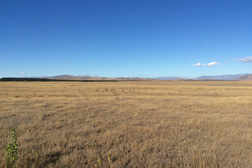
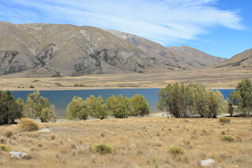
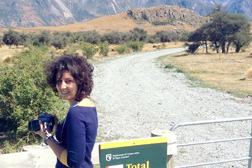

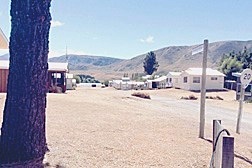
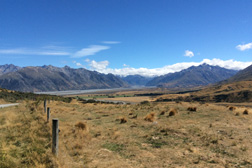
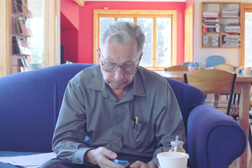
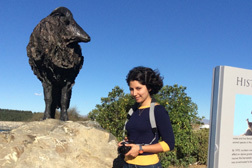
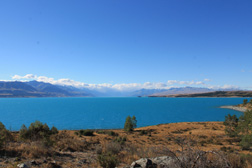
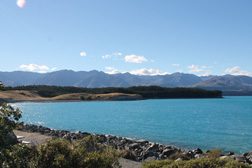
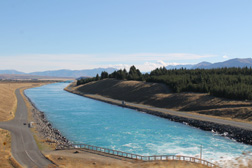

 | ||
|---|---|---|
 | One of the items we rented with the campervan was a New Zealand street map GPS receiver. This turned out to be much more useful for finding places than my meticulously planned itinerary. The only problem was that it was not possible to know to what kind of road we were being directed, and it eventually became clear that the road to Mount Sunday, the filming location for Edoras in LOTR was not the stretch of road repair I thought it was. By the time we reached that conclusion, we were over half way back to the main highway, so we pressed on. Although this area is dotted with mountains, much of the land in this part of South Island is exceptionally flat. I was suprised to see lakes on what I thought was much drier terrain. |  |
 | Here Pegah and I are taking pictures of Mount Sunday (in the background), the location of Edoras, the capitol of Rohan in The Two Towers. The movie set consisted of Meduseld, the Golden Hall, and surrounding buildings at the top, and more buildings at its foot. At the end of filming, the set was dismantled and the area returned to its natural state. Although none of the actual set remains, the spectacular views of Mt Sunday sitting all alone in an expansive river plain surrounded by the Southern Alps still attracts hundreds of visitors each year. There is an all day tour from Christchurch. A recently added trek route has been constructed so visitors can walk up to Mount Sunday and even climb to the top. (We didn't do that!) |  |
 | Close to Mount Sunday is Mount Potts Station, a backcountry isolated working cattle farm, restaurant and lodge. The original Mt Potts homestead, shearer's quarters and wool shed were converted into an accommodation and restaurant complex, known today as Mt Potts Lodge. It doubles up as a heliski base in the winter. Unlike normal resorts, there are no fixed ski tows or chairlifts. Instead, vertical transport is provided by snowcats and helicopter. The ski area covers 1630 acres and includes "steep faces, chutes, rocks to drop off, cornices, wide open powder bowls and gullies." At this time of year, of course, there was no snow. The photo on the right reminded me of the entrance to Helm's Deep in LOTR. |  |
 | By the time we arrived at Fairlie on our way to Lake Pukaki, we realized that our campervan did not have the air conditioing we had paid for. Here I am trying unsuccessfully to find out how to get it fixed. After getting no response from the Kiwi Camper people except, "Just push the button and make sure the green light is on," we eventually found a mechanic who informed us that the system was "bone dry." Frustrated, we pushed on to Lake Pukaki, which, for some reason, has a statue dedicated to Himalayan Tahr sheep (here watching Pegah watching me). These were introduced for game in 1904. Like most invasive species, they soon overpopulated their environment and are now controlled through culling. |  |
 | The shores of the lake were used for two sets in The Hobbit. The one on the left for part of the warg chase that ended with the dwarves finding the tunnel to Rivendale, and the area on the right was the site of the refugee camp after the destruction of Laketown. Neither of these locations was obvious, and I spend some time looking for them. Had I realized exactly where they were at the time, I would have framed the photos differently. As it was, both photos show the intense blue color of the water that is imparted by finely ground rock flour washed into the Tasman River from the glaciers. These deposited the rocky debris that dammed the river and formed Lakes Pukaki, Tekapo and Ohau. |  |
 | Lake Pukaki is connected to Lake Tekapo through a canal, forming a hydroelectric reservoir that provides over half of New Zealand's hydroelectricity storage capacity. Normally, the level of the lake varies from 1700 to 1744 feet above sea level, but it can be drained to 1683 feet during an energy emergency. Originally, the lake fed the Pukaki River, but the outflow is now diverted through the Ohau A power station to Lake Ruataniwha. The lake's distinctive blue color is obvious in the outfall from the power station. We made use of all this energy availability while staying at the Omerama Top 10 Holiday Park, where we plugged in our campervan and charged Pegah's smart phone and my iPad overnight. |  |
| Click here to go to the next page. | ||